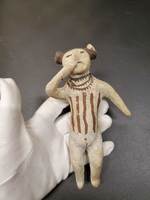Doll by Nina Weissbach
This ceramic Hopi doll figurine was collected by J.W. Fewkes in Arizona. Her entire body is coated in a layer of white slip. Her hair, necklace, and other anatomical features (excluding her navel) are distinguished using a dark brown paint. Her navel is marked with the same paint as the vertical auburn stripes down her chest and belly. While many may assume her gender by her jewlery or hair style, she genital region provides evidence for her sex, as she has a clear and deliberate slit running from front to back in between her legs. Unlike her upper body, her pelvic region and legs seem to have a more realistic and defined structure to them; her upper body is and arms seem to be more cylindrical in nature, as if the clay was rolled and connected to add appendages and pinched to create a shape for the head and nose. Additionally, upon examining the paint colors which were used for the making of this doll, we found it interesting that the color chosen for her base coat, which effectively translates to her skin, was so light when hopi lifestyle and environment would likely result in a darker skin tone.
It is unclear what the cause of some of her damages were, her largest notable loss has been a chip to her left bun, likely from being hit into another surface or dropped. She has also experienced chipping of her brown, auburn and white paint. However, the crackling of her white base paint suggests that her brown and auburn chips may just be due to the deteriorating status of the underlying coat. The most interesting “flaw” found on the doll are her light gold blushes on the right side of her nose, left side of her face ranging from above her hairline to her lower chin, her lips and her right forearm. Blushes are burn marks from the combination of the iron in the clay and the kilns flame. Many Hopi artists perceive these marks as lucky, since they make the piece even more unique and are uncontrollable. If you look closely, you can see the faintest marks for blushes also on her upper right abdomen, along the outside of the left arm and leg. She also has a large mark along the left side of her neck with an unclear origin due to its blush-like coloring but opaque outer edges.
During research, we struggled to find other Hopi dolls like the one in our collection. However, we do know that dolls have played a large role in the history of the Hopi people. Dolls have served as modes of entertainment, communication and assimilation. Hopi children did play with dolls, such as the one we have in our collection. However, there was a different type of doll that held a large amount of influence in the Hopi community prior to colonial interference, the Kachina, or Katsina, doll. These ceramic and wooden carved dolls, known as tithu or katsintithu in the Hopi language, serve to teach young girls or brides about immortal beings. Said beings possess powers which can influence the people and nature around them. Additionally these beings can serve as communicators between the mortal and spirit worlds. They are easily identified by the presence of their masks, as well as other notable features associated with the spirit they are meant to represent.
As the United States began to implement policies of assimilation of Indigenous peoples into the newly developing American ideal, colonial activists introduced new styles of dolls to the children. These new dolls embodied the developing establishment of American cultural dress and presentation. Assimilation dolls were substituted for the dolls Indigenous children normally used, in order to provide representation of the children’s new expectations as many were transitioned out of their family’s traditions and into new American lifestyles.
